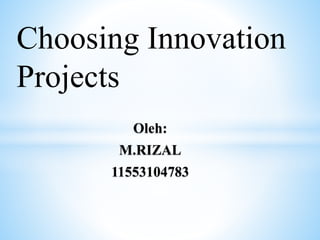
Chapter 8
- 2. * Developing innovative new products and services is expensive and time-consuming. It is also extremely risky—most studies have indicated that the vast majority of development projects fail. Firms have to make difficult choices about which projects are worth the investment, and then they have to make sure those projects are pursued with a rigorous and well-thought-out development process. In this chapter, we will explore the various methods used to evaluate and choose innovation projects. The methods range from informal to highly structured, and from entirely qualitative to strictly quantitative. We will start by considering the role of capital rationing in the R&D investment decision, and then we will cover various methods used to evaluate projects including strictly quantitative methods, qualitative methods, and approaches thatcombine quantitative and qualitative techniques. *OVERVIEW
- 3. * *QUANTITATIVE METHODS FOR CHOOSING PROJECTS 1. Discounted Cash Flow Methods Many firms use some form of discounted cash flow analysis to evaluate projects. Discounted cash flows are quantitative methods for assessing whether the anticipated future benefits are large enough to justify expenditure, given the risks. Discounted cash flow methods take into account the payback period, risk, and time value of money 2. Net Present Value (NPV) the cash flows the project will yield (often under a number of different “what if” scenarios). Costs and cash flows that occur in the future must be discounted back to the current period to account for risk and the time value of money. 3. Internal Rate of Return (IRR) The internal rate of return of a project is the discount rate that makes the net present value of the investment zero 4. Real Options When a firm develops new core technologies, it is simultaneously investing in its own learning and in the development of new capabilities
- 4. Quantitative methods for analyzing potential innovation projects can provide concrete financial estimates that facilitate strategic planning and trade-off decisions. They can explicitly consider the timing of investment and cash flows and the time value of money and risk. They can make the returns of the project seem unambiguous, and managers may find them very reassuring. However, this minimization of ambiguity may be deceptive; discounted cash flow estimates are only as accurate as the original estimates of the profits from the technology, and in many situations, it is extremely difficult to anticipate the returns of the technology. *DISADVANTAGES OF QUANTITATIVE METHODS
- 5. * Conjoint Analysis is a family of techniques (including discrete choice, choice modeling, hierarchical choice, trade-off matrices, and pairwise comparisons) used to estimate the specific value individuals place on some attribute of a choice, such as the relative value of features of a product or the relative importance of different outcomes of a development Project 2. Data Envelopment Analysis is a method of assessing a potential project (or other decision) using multiple criteria that may have different kinds of measurement units.23 For instance, for a particular set of potential projects, a firm might have cash flow estimates, a ranking of the project’s fit with existing competencies, a ranking of the project’s potential for building desired future competencies, a score for its technical feasibility, and a score for its customer desirability *COMBINING QUANTITATIVE AND QUALITATIVE INFORMATION
- 6. * 1. Firms often use a combination of quantitative and qualitative methods to evaluate which projects should be funded. Though some methods assume that all valuable projects will be funded, resources are typically constrained and firms must use capital rationing. 2. The most commonly used quantitative methods of evaluating projects are discounted cash flow methods such as net present value (NPV) or internal rate of return (IRR). While both methods enable the firm to create concrete estimates of returns of a project and account for the time value of money, the results are only as good as the cash flow estimates used in the analysis (which are often unreliable). Both methods also tend to heavily discount long-term or risky projects, and can undervalue projects that have strategic implications that are not well reflected by cash flow estimates. 3. Some firms now use a real options approach to assessing projects. Real options better account for the long-run strategic implications of a project. Unfortunately, many new product development investment decisions do not conform to the assumptions inherent in an options valuation approach *Summary of Chapter
- 7. * 4. One commonly used qualitative method of assessing development projects is to subject the project to a series of screening questions that consider the project from multiple angles. These questions may be used merely to structure the discussion of a project or to create rating scales that are then utilized in an approach that combines qualitative and quantitative assessment. 5. A company’s portfolio of projects typically includes projects of different types (e.g., advanced R&D, breakthrough, platform, and derivative projects) that have different resource requirements and different rates of return. Companies can use a project map to assess what their balance of projects is (or should be) and allocate resources accordingly. 6. Q-sort is a qualitative method of assessing projects whereby individuals rank each project under consideration according to a series of criteria. Q-sort is most commonly used to provide a format for discussion and debate. 7. Conjoint analysis is a method of converting qualitative assessments of a choice into quantitative weights of the different criteria underlying the choice. It is most often used for assessing how customers value different product attributes. 8. Data envelopment analysis (DEA) is another method that combines qualitative and quantitative measures. DEA enables projects that have multiple criteria in different measurement units to be ranked by comparing them to a hypothetical efficiency frontier. *Summary of Chapter
- 8. *THANK YOU